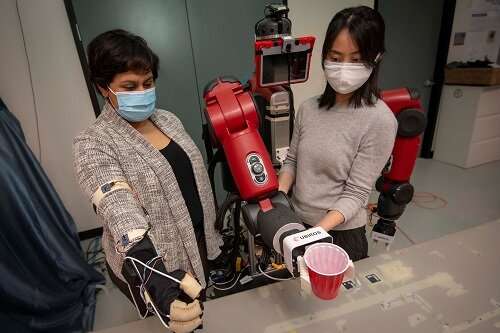Inspired by pandemic needs, humanoid nursing robots under development could help medical staff care for patients

Inspired by healthcare needs during the COVID-19 pandemic, Assistant Professor of Robotics Engineering Jane Li is leading a team of researchers on a project to develop advanced remote-controlled humanoid nursing robots that can help medical workers care for patients who are in quarantine or isolation.
The researchers, who expect to begin testing a new prototype this summer, are aiming to develop a user-friendly robot that can perform nursing-related tasks in settings where a high risk of contagion or infection threatens the health of nurses.
Although medical robots are used in major hospitals today, Li says, they are difficult to learn to use and difficult to operate, which often increases nurses' workloads.
To solve this challenge, Li is continuing development of a Tele-Robotic Intelligent Nursing Assistant (TRINA), a mobile, humanoid robot that has arms equally strong and gentle to transport medications or infectious samples, help patients adjust their positions, and even lift and carry a patient. TRINA was developed at Duke University in 2016; Li was a postdoctoral researcher on the project.
According to Li, TRINA could benefit patients as well as healthcare staff who are dealing with an aging American population and a persistent nursing shortage.
"I understand the heavy workloads and the stress that nurses encounter, and their fear of being exposed to infectious diseases as they care for patients," says Li, who is principal investigator (PI) on the project and director of WPI's Human-Inspired Robotics Lab. "These TRINA robots can relieve physical and emotional stress on healthcare workers. We are hoping this will revolutionize patient care, a benefit that can extend to in-home care and clinics."
Nurse shortage
COVID-19 has emphasized the ongoing need for technologies that can assist healthcare workers. Since the onset of the pandemic in 2020, healthcare workers have been straining under long work hours, heavier workloads, and the fear of contracting the virus themselves. Over the past two years, more than 1 million U.S. healthcare workers were infected with COVID-19 and more than 4,000 of them died, according to the CDC.
Even before the pandemic, a shortage of nurses plagued the medical field. According to Bureau of Labor Statistics Employment projections, there will be an average of 194,500 registered nurse job openings in the United States each year over the decade ending in 2030. Many of those openings are expected to result from the need to replace workers who retire, transfer to different occupations, or exit the labor force.
To help ease these situations, Li is working on the project with co-principal investigator Cagdas Onal, associate professor of robotics engineering and director of the WPI Soft Robotics Lab. Onal is creating haptic gloves, which are wearable devices that will enable the nurse operating the robot to feel what the robot senses and to better control the robot's movements. The haptic gloves will enable nurses to direct the robot's hand movements in real time.
Onal, whose research has focused on creating strong, but soft, robotics, says the haptic gloves are designed for high-accuracy of mirrored movements, enabling the robot to replicate the nurse's hand gestures in real time.
"It will enable the nurses to feel as though they are doing these tasks in person, while avoiding being in potentially dangerous conditions," he says.
Li adds that nurses typically do not learn how to operate robots in nursing school, "so it needs to feel natural for them to want to use a robot. We're designing the system so they will feel the robot is acting as if it's an extension of their own body. At the same time, they can feel what the robot is touching."
Instead of operating the robot using a keyboard or game controller, nurses would wear headsets that would enable them to see what the robot sees.
Human-robot interaction
Li also is working with co-principal investigator Jie Fu, assistant professor at the University of Florida, who is designing a user interface that is easier to understand, along with learning methods to make it easier for novice users to handle and learn the interface. (Fu was a faculty member in the WPI Department of Robotics Engineering when the NSF-CDC grant was awarded and is continuing to work on the project through a subaward.)
Fu's work is focused on developing adaptive controls for the nursing robot to enable both expert and novice users to easily direct it. Using game theory, which applies mathematical models to strategize interactions, Fu is working to offer a better user experience, to enhance the robot's performance, and to enable the robot to better learn from repeated operations. The system is being designed so a caregiver could be trained to operate the robot within two hours.
"The system is more than just the physical robot," Fu says. "It's also about an autonomous system that interacts with the nurse running it."
The system will enable the robot to learn repeated tasks. Once a robot has repeatedly performed a task, such as removing a blanket from the patient's bed or retrieving specimens, it will be able to do these tasks without being given step-by-step instructions. The robot also is being designed to help new users learn to work with it—giving users messages about next steps needed to perform specific tasks or how to move their hands appropriately with the haptic gloves.




















